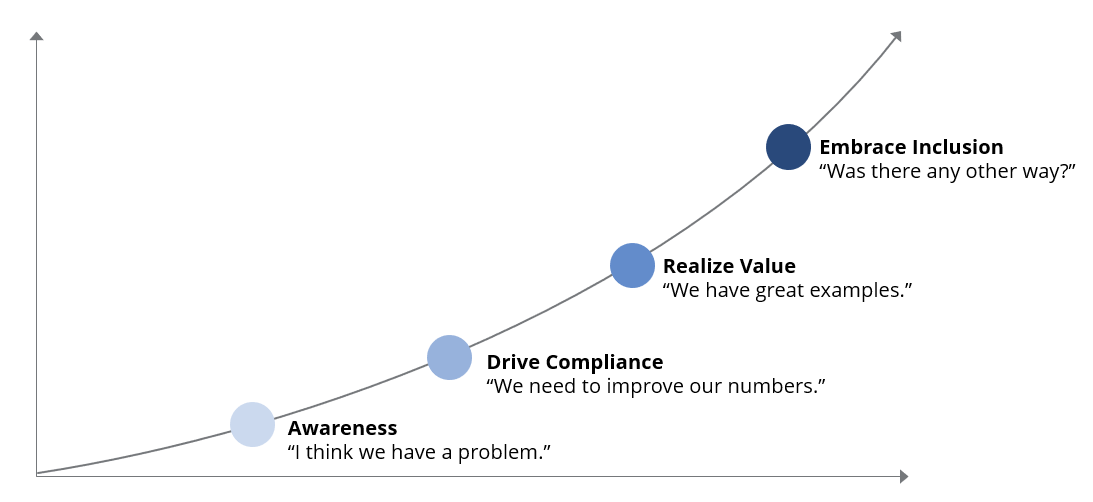When you peruse the internet on the topic of workforce diversity, you are quickly bombarded with ratios of women to men in leadership positions, pay equality statistics and reasons why inclusion is important to a company’s bottom line. As a woman working in a male-dominated IT industry for almost 30 years, I greatly appreciate this relatively new emphasis on inclusivity in the workforce as a boon to the industry. But is the focus on achieving satisfactory ratios the true indication of success? Or are the signs of a truly diverse workforce something much more fundamental? In other words, should we “check the box” simply because our numbers are improving?
Just to clarify, there are two buzzwords people tend to use when they speak on this topic: diversity and inclusion. Diversity represents who makes up your workforce. A diverse workforce means your staff resembles the environment of which your workforce is a part, typically including representation across gender, age, ethnicity and social/economic background. Inclusion represents how you achieve that diversity – the policies and practices a company implements to actively strive for and maintain a diverse workforce.
So, back to the question of checking the box: how does a company know it is making progress in achieving diversity? Whether considering the status of a whole company or just a team, recognizing how you operate today in comparison to “what good looks like” will generate constructive discussions and help identify specific actions for making progress. The curve below represents a typical progression.

Figure 1: Organizational Diversity Progression Curve
Stage 1 – Awareness. Based on the statistics alone, it is clear the technology industry is not diverse. But don’t be dismayed. What is important is to know your numbers, recognize you have a problem and commit as a leadership team to construct an action plan. Equally imperative is to articulate why this is important. It has been proven that diversity enhances innovation, increases quality and stability, and enables the company to relate more effectively to their customers. But a more fundamental byproduct is that promoting a diverse workforce means you value all individuals – not just those who have traditionally been successful. Continuing with the status quo may disenfranchise individuals in the organization, and recognizing the problem begins the work of inclusion.
Stage 2 – Drive Compliance with Better Practices. Working toward a certain set of ratios, although not the end goal, is an important step. It is hard to dispute the numbers. Numeric goals enforce a change in behaviors. First, be realistic with multi-year goals so you don’t force percentages that cause poor decisions. The overall intent of diversity is to be inclusive – not drive animosity across the workforce. Second, evaluate resource management criteria. Repeatedly having to arbitrarily select women to meet a quota reflects that current policies and mechanisms for recruiting, hiring, performance and promotion practices are out of date. Hiring and promotion criteria often reflect the traits of those who have traditionally been viewed as high performers, which may not reflect a broad set of traits that foster a diverse and effective team. Don’t let outdated practices undermine progress by devaluing non-traditional qualities.
Stage 3 – Realize Value. Undoubtedly, there are great examples of non-typical promotions or uniquely diverse teams hitting the ball out of the park. Spend a bit of time understanding the traits or dynamics of the individual or team that made them so successful. Often the factors include a personality trait that enabled a more effective relationship with a customer, a more empathetic leadership style to promote team productivity or a skill not readily found in the current workforce. Celebrate the successes of those teams or individuals. Promoting examples of diversity will not only continue to change perceptions across the organization, but it also will signal to all individuals that they are valued and encouraged to advance. As the executive team continues to promote new practices, and diverse individuals or teams expand their influence in the company, progress toward – and the benefits of – inclusion can become exponential.
Stage 4 – Embrace Inclusion. Embrace is a strong word – meaning taking action enthusiastically and with no hesitation. When inclusion becomes part of the DNA of the organization – and the workforce is truly diverse – the need to track numbers becomes irrelevant.
I am optimistic about the trajectory of inclusion in the IT industry because we are the solution. When women and minorities become leaders and serve in strategic positions, the change is indelible. This is a call to all of us who not only have a voice but have the responsibility to act. Let’s not allow ourselves to merely “check the box.” Let’s engage those who would not have otherwise been asked. Let’s increase our influence through mentoring and advocacy. And let’s actively remove traditional barriers.
